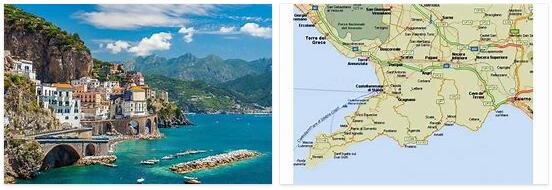Saturnia
Thermal resort in Tuscany
The village of Saturnia with its thermal baths is located in the province of Grossetto in Italy. It belongs to the Maremma region in southern Tuscany and is a district of the municipality of Manciano.
Where the Etruscans used to bathe
The main attraction of the trip are the thermal baths not far from the village, whose sulphurous, 37 degrees warm water pours like a waterfall into lime sinter terraces. 800 liters of healing water flow from the thermal spring per second, which has a beneficial effect on the skin and joints and can have convalescent effects on rheumatism and osteoarthritis. The public part of the thermal baths is freely accessible around the clock. The nearby thermal hotel offers a comfortable bathing area with the same thermal water, which is also open to non-hotel guests for a fee.
Memories of Roman times
In addition to the thermal baths, it is worth visiting the Porta Romana – a well-preserved, antique archway in the southern city wall of the village of Saturnia on the former Roman trade route Via Clodia. The Chiesa di Santa Maria Maddalena is nicely embedded in the beautiful landscape. It was built on the ruins of an ancient Romanesque church and holds breathtaking art treasures hidden inside. The precious panel of the “Madonna and Child between Saint Sebastian and Maria Magdalena” from the 15th century should be emphasized – a masterpiece with angelic-looking figures processed with gold thread. Two beautifully carved processional crosses from the 18th century, a pair of angel candelabra from the 17th century and paintings of Saints Clara and Elisabeth of Hungary complete the study trip.
Segesta
Temple with a view
The largest Italian island on the Mediterranean with the best oil and probably the most impressive ruins and temples. Sicily is an island of superlatives, if you want to take your eyes off the dreamy sea and look at the stunning landscape.
Magical landscape and impressive sights
In addition to the Etna volcano, the breathtaking coastal landscapes and the Mediterranean sun, one impressive building in particular made us speechless.
The temple complex of Segesta is one of the best preserved buildings in the world and promises not only an impressive insight into history, but also a view that you will not have again anytime soon. In front of the Greek temple built on a hill, the Mediterranean Sea stretches out in all its beauty.
The current ruined city in the north-western region of Trapani was destroyed at the beginning of the 5th century and has not been settled since then.
Performances in the Colosseum of Segesta
At the foot of the Acropolis, built in the Greek style, is the Segesta theater (Colosseum), which has something very special in store for visitors, especially in summer. At this time, open-air performances take place at regular intervals. Entertainment like in ancient Greece, a must for every visit!
The archaeological site can be reached on foot within a few minutes from the car park on the Mte. Barbaro hill. But if you want the promised view from the Acropolis, you can take a shuttle bus from the ruined city, or you can dare to walk within 20 minutes.
With its diversity, Sicily offers a wide range of impressions that will probably impress every one of its visitors.
Amalfi
Showcase town with old treasures
The small town of Amalfi is located in Italy in the Campania region at the foot of the Lattari mountain range. It is part of the Amalfi Coast, which is a UNESCO World Heritage Site. The Amalfi Coast attracts many travelers and inspires with its unique flair and spectacular views. Amalfi impresses with its picturesque hillside location at the exit of the Valle dei Mulini valley. The townscape is characterized by narrow streets that are spanned by arcades.
Small town with a large cathedral
The highlight of every study trip to this region is the St. Andrea Cathedral of Amalfi. It was built in the 10th century in Romanesque style and has three naves. The cloister, which is well worth seeing, is connected to the cathedral. The facade is impressive with its pointed arch windows and the mosaics decorated with gold. The bell tower has Arabic and Roman stylistic elements. Access to the cathedral is via an imposing flight of 62 steps. (Admission 3 €, free during mass) A painting of the apostle Andrew, to whom this church is dedicated, stands out above the entrance portal. Inside the church, the gaze falls on the wooden cross from the 13th century above the high altar. It is also worth putting your head back: The unusual ceiling painting shows the patron saint of Amalfi,
In front of the cathedral, on the charming, lively Domplatz, there are numerous cafes, restaurants, souvenir shops and limoncello shops where you can enjoy the typical Italian ambience.
Other attractions: four museums and a port
The citizens’ museum in the town hall presents the history of the city of Amalfi. Anyone who has always wanted to know how paper was made in the past will find what they are looking for in the Paper Museum, which maintains the old craft of paper making. Lemon and limoncello specialties can be tasted in the rural lemon museum. The ancient city gate Porta della Marina is also worth seeing. The museum in the old shipyard deals with the history of seafaring. A visit to the port with its small beach and the Piazza Flavio Gioia, on which a monument is dedicated to the seafarer of the same name, rounds off the trip to Amalfi.
